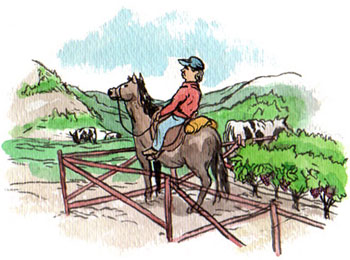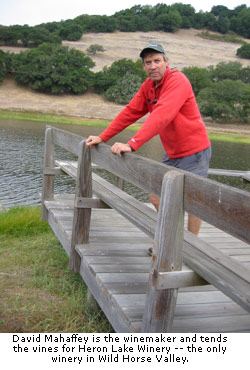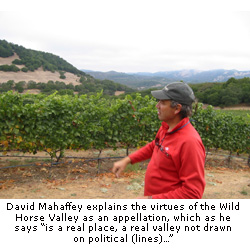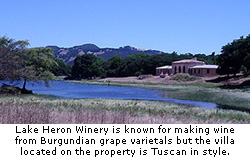

David Mahaffey is a lone ranger. The winemaker for the
only winery in the Wild Horse Valley.
Wild Horse Valley ~ Napa Valley (AVA)
The Lone Ranger of Wild Horse Valley: An interview with David Mahaffey
“(Wild Horse Valley) is a real place, a real valley not drawn on political (lines), but physical soil types -- peak-to-peak.”
by
Alan Goldfarb
December 7, 2006
Alan Goldfarb (AG): Wild Horse is still a little secret, isn’t it? I have the feeling that you like that?
 David Mahaffey (DM): I think so. Perversely, I’ve long reveled that this is the only wine (Heron Lake) that has this appellation. That’s no longer the case, but I do enjoy the singularity of it.
David Mahaffey (DM): I think so. Perversely, I’ve long reveled that this is the only wine (Heron Lake) that has this appellation. That’s no longer the case, but I do enjoy the singularity of it.
AG: Is it ever going to change, get larger? Will we see more fruit coming out of there?
DM: I think so. There will be other people who will desire to plant. There’s a new vineyard that neither one of us (he and John Newmeyer, Heron Lake’s owner) has seen before. It’s close to the minimum 1,000-foot limit, but I’m going to see if it is (within the AVA boundaries).
AG: Has David Abreu (controversial superstar vineyardist and now vintner) planted a vineyard, as you thought he might?
DM: I thought he might be but I don’t think it’s in the Wild Horse area. I had heard that.
AG: It begs the question, why haven’t we seen more plantings?
DM: One of the reasons is that a big chunk of the valley has two lakes that are owned as a watershed for the cities of Vallejo and Fairfield (both in Solano County to the east) and they have been very restrictive in allowing access because they want to keep the water pristine. You can’t get a permanent registration to travel on the roads.
AG: But you can get up to Heron Lake from the Napa side. What about that?
DM: There are three large parcels that dominate, and they’re not interested in growing grapes, nor is there great access. The Tudor Ranch has 1,000 acres and there’s another large ranch on the other side called Green Valley Ranch and then there’s Wild Horse Valley Ranch, which is a horse ranch.
The ranch partners fear that there’s too much agriculture. Vineyards would be too close to houses.
AG: And what of the Wild Horse Valley Ranch? It’s the largest property up there. John Newmeyer thought it would have to be sold in order for Wild Horse to proliferate because he told me, “That’s where most of the precious soils lie.”
DM: There are just not any parcels that come up for sale (here). In the north end, there are very large parcels that could be developed.
 AG: But those are on those ranches you mentioned. So, Wild Horse is sort of land-locked.
AG: But those are on those ranches you mentioned. So, Wild Horse is sort of land-locked.
DM: Right.
AG: You’ve told me that the appellation “is a real place, a real valley not drawn on political (lines), but physical soil types -- peak-to-peak.” Explain further, please.
DM: The valley is five miles long overall. It’s not a perfect north-south valley; it has intermediate ridges. More importantly, (the AVA wasn’t drawn with) arbitrary political boundaries for water sheds or grant deeds. It’s a real place. It’s upland with mineral rich soils, with a minimum elevation of 1,000 feet which defines its coolness.
The fact that the wind is at the southern end, puts it in a direct path for the cool breezes that get sucked out of San Pablo Bay up to 1,400-1,500 feet. That steady, direct path means cooler breezes.
AG: And you’ve called Wild Horse “a bit of an odd duck” for its obscurity, caught as it is between two regions.
DM: It’s not odd in the sense of being unusual. Ironically, it has some of the best conditions for some of the best grape-growing in the area.
It’s cooler than Carneros for sure, which is much more interesting. It has mountaintop, volcanic soils. With Carneros Pinots, and I don’t mean to sound pejorative, Carneros’ reputation as a premiere Pinot Noir region has been eclipsed by cooler locations.
 As for Chardonnay, we have new inter-plantings. It’s a fabulous spot for it -- it is cool, and it has rocky, mineral-rich soils. There’s a certain minerality that I can perceive in both the Pinot and the Chardonnay. It’s a true definition of terroir.
As for Chardonnay, we have new inter-plantings. It’s a fabulous spot for it -- it is cool, and it has rocky, mineral-rich soils. There’s a certain minerality that I can perceive in both the Pinot and the Chardonnay. It’s a true definition of terroir.
AG: When I visited a little more than a year ago, the winery for Heron Lake was just about to be built. Is it done, and if so, does that mean that Wild Horse now has its first winery and caves?
DM: No (laughs). We haven’t even broken ground. So, we don’t have a winery yet, but it’s still planned. We’re making the wines at Kirkwood Reid Winery in southwest Napa.
AG: So, Wild Horse is still the only AVA in the country without a winery?
DM: Afraid so.
~ Alan Goldfarb, Regional Correspondent – Napa Valley
To comment on Alan Goldfarb’s writings and thoughts, contact him at a.goldfarb@appellationamerica.com
 David Mahaffey (DM): I think so. Perversely, I’ve long reveled that this is the only wine (Heron Lake) that has this appellation. That’s no longer the case, but I do enjoy the singularity of it.
David Mahaffey (DM): I think so. Perversely, I’ve long reveled that this is the only wine (Heron Lake) that has this appellation. That’s no longer the case, but I do enjoy the singularity of it.AG: Is it ever going to change, get larger? Will we see more fruit coming out of there?
DM: I think so. There will be other people who will desire to plant. There’s a new vineyard that neither one of us (he and John Newmeyer, Heron Lake’s owner) has seen before. It’s close to the minimum 1,000-foot limit, but I’m going to see if it is (within the AVA boundaries).
AG: Has David Abreu (controversial superstar vineyardist and now vintner) planted a vineyard, as you thought he might?
DM: I thought he might be but I don’t think it’s in the Wild Horse area. I had heard that.
AG: It begs the question, why haven’t we seen more plantings?
DM: One of the reasons is that a big chunk of the valley has two lakes that are owned as a watershed for the cities of Vallejo and Fairfield (both in Solano County to the east) and they have been very restrictive in allowing access because they want to keep the water pristine. You can’t get a permanent registration to travel on the roads.
AG: But you can get up to Heron Lake from the Napa side. What about that?
DM: There are three large parcels that dominate, and they’re not interested in growing grapes, nor is there great access. The Tudor Ranch has 1,000 acres and there’s another large ranch on the other side called Green Valley Ranch and then there’s Wild Horse Valley Ranch, which is a horse ranch.
The ranch partners fear that there’s too much agriculture. Vineyards would be too close to houses.
AG: And what of the Wild Horse Valley Ranch? It’s the largest property up there. John Newmeyer thought it would have to be sold in order for Wild Horse to proliferate because he told me, “That’s where most of the precious soils lie.”
DM: There are just not any parcels that come up for sale (here). In the north end, there are very large parcels that could be developed.
 AG: But those are on those ranches you mentioned. So, Wild Horse is sort of land-locked.
AG: But those are on those ranches you mentioned. So, Wild Horse is sort of land-locked.DM: Right.
AG: You’ve told me that the appellation “is a real place, a real valley not drawn on political (lines), but physical soil types -- peak-to-peak.” Explain further, please.
DM: The valley is five miles long overall. It’s not a perfect north-south valley; it has intermediate ridges. More importantly, (the AVA wasn’t drawn with) arbitrary political boundaries for water sheds or grant deeds. It’s a real place. It’s upland with mineral rich soils, with a minimum elevation of 1,000 feet which defines its coolness.
The fact that the wind is at the southern end, puts it in a direct path for the cool breezes that get sucked out of San Pablo Bay up to 1,400-1,500 feet. That steady, direct path means cooler breezes.
AG: And you’ve called Wild Horse “a bit of an odd duck” for its obscurity, caught as it is between two regions.
DM: It’s not odd in the sense of being unusual. Ironically, it has some of the best conditions for some of the best grape-growing in the area.
It’s cooler than Carneros for sure, which is much more interesting. It has mountaintop, volcanic soils. With Carneros Pinots, and I don’t mean to sound pejorative, Carneros’ reputation as a premiere Pinot Noir region has been eclipsed by cooler locations.
 As for Chardonnay, we have new inter-plantings. It’s a fabulous spot for it -- it is cool, and it has rocky, mineral-rich soils. There’s a certain minerality that I can perceive in both the Pinot and the Chardonnay. It’s a true definition of terroir.
As for Chardonnay, we have new inter-plantings. It’s a fabulous spot for it -- it is cool, and it has rocky, mineral-rich soils. There’s a certain minerality that I can perceive in both the Pinot and the Chardonnay. It’s a true definition of terroir.AG: When I visited a little more than a year ago, the winery for Heron Lake was just about to be built. Is it done, and if so, does that mean that Wild Horse now has its first winery and caves?
DM: No (laughs). We haven’t even broken ground. So, we don’t have a winery yet, but it’s still planned. We’re making the wines at Kirkwood Reid Winery in southwest Napa.
AG: So, Wild Horse is still the only AVA in the country without a winery?
DM: Afraid so.
~ Alan Goldfarb, Regional Correspondent – Napa Valley
To comment on Alan Goldfarb’s writings and thoughts, contact him at a.goldfarb@appellationamerica.com












